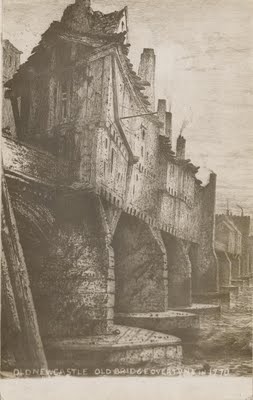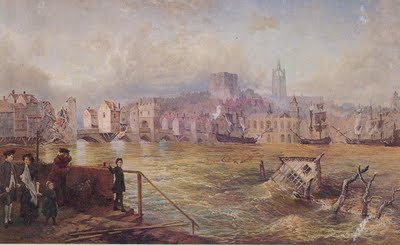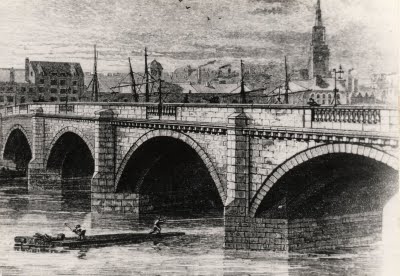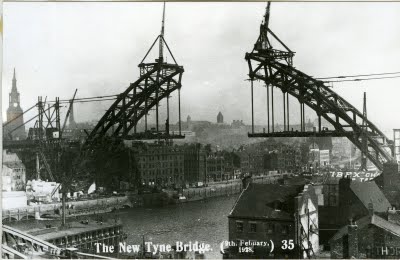Tyne Bridges at Gateshead
Welcome to the Tyne Bridges at Gateshead page which brings you pictures and text about the Bridges over the Tyne between Central Gateshead and Central Newcastle from Romans times to today
This stone bridge was built in 1270. Left click this and other images to see them enlarged
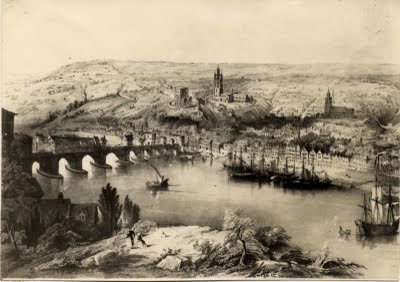
Here's the bigger picture and left click to see it bigger. There may have been more than one bridge at Newcastle in the middle ages but the first of which anything is known was probably built in the late 12th century replacing a bridge destroyed by fire in 1248. This was a stone arched bridge with huge piers built on the site of the Roman bridge and was a joint enterprise between Newcastle and the Bishop of Durham and the Bishop's arms appeared on a tower at the Gateshead (in County Durham) end of the bridge. Towers with gates and a drawbridge and portcullis reflected the bridge's military significance and a chapel was a feature not unusual for the times. A prison was also incorporated and several shops and houses, particularly at the Gateshead end, completed its picturesque appearance.
The upkeep of the bridge was divided between the town of Newcastle and the Prince Bishops of Durham and boundary stones marked their limits of responsibility. Rivalry between the town and the Bishops caused friction on occasion. Newcastle eventually controlled six arches to the Bishop's four. Frequent repairs were needed over the centuries, the last being effected in 1770 after an adverse report on its condition.

Here's the bigger picture and left click to see it bigger. There may have been more than one bridge at Newcastle in the middle ages but the first of which anything is known was probably built in the late 12th century replacing a bridge destroyed by fire in 1248. This was a stone arched bridge with huge piers built on the site of the Roman bridge and was a joint enterprise between Newcastle and the Bishop of Durham and the Bishop's arms appeared on a tower at the Gateshead (in County Durham) end of the bridge. Towers with gates and a drawbridge and portcullis reflected the bridge's military significance and a chapel was a feature not unusual for the times. A prison was also incorporated and several shops and houses, particularly at the Gateshead end, completed its picturesque appearance.
The upkeep of the bridge was divided between the town of Newcastle and the Prince Bishops of Durham and boundary stones marked their limits of responsibility. Rivalry between the town and the Bishops caused friction on occasion. Newcastle eventually controlled six arches to the Bishop's four. Frequent repairs were needed over the centuries, the last being effected in 1770 after an adverse report on its condition.
But one year later the bridge succumbed to the devasting great floods which followed three days of heavy rain which eventually carried parts of the bridge away on the morning of Sunday November 17. The middle arch collapsed to be followed by two more. Shops and houses fell or were rendered unsafe and six people lost their lives. More arches collapsed in the period to December 7 and this completed the destruction of the old bridge. An arch remains under the Swing Bridge roadway at the Newcastle side.
In 1781, a new stone bridge across the Tyne was completed.
While dealing with the Tyne here's snippets of news from the Historical Register of 1833 and 1834
1833 June 13. The largest number of salmon was caught in the
Tyne that had taken place for many years. Between four and five
hundred were brought into Newcastle market, and were readily
sold at from 6d. to 8d. per pound.
1834 January 28. Newcastle Gateshead and the neighbourhood was visited by a severe storm, of wind and rain, as were all the western parts of the county. From the circumstance of the Tyne rising to an enormous height and overflowing its banks, the whole of the district below Blaydon, including Derwenthaugh, Scotswood, Dunstan, &c., was completely under water, and in many of the houses it was nearly up to the second floor.
1834 March 20. A fine vessel of a boat eight keels burden, and the
only one ever built above ie west of the Tyne bridge, was launched at Chatham (western end of Pipewellgate), in the presence of a large assemblage of spectator*.
She was called The Frolic, and intended for the Baltic trade.
1838 January 6. Frost of an extreme intensity prevailed throughout
the northern counties, and the first snow of the winter fell
this day, the wind blowing keen from the north-east, the storm
continued with great severity till the end of the month. All
passage on the river Tyne was stopped, it being frozen for upwards
of five miles below Newcastle, and crowds of skaters appeared
upon it. In no year since the celebrated frost of 1814
had one occurred like the present. In proof of this it may be
mentioned that loaded carts crossed the Tyne, the Coquet, the
Tweed, and other rivers in the north, upon the ice at various
points.
1838 September 4. Thomas Cowley. a pipemaker, of Gateshead,
undertook, for a trifling wager, to leap from Newcastle bridge
into the Tyne and was drowned. A more successful act of folly
of the same kind was perpetrated in September, 1850.
1840 February 1. A dreadful collision took place in the river
Tyne, near Friar's Goose. The London Merchant Steamer was
going down the river on her voyage to London, and the brig Good
Intent, from Lynn, laden with flour, was sailing up, towed by
the steam-tug Margaret, when they came violently in contact
with each other. The Good Intent was struck on the larboard-bow,
and in a few minutes went down. The crew had just time to save
their lives.
1866 September 17. Arrangements having been made by the River
Tyne Commissioners with the Corporation of Newcastle, the
Lords of the Admiralty gave their consent to erect a new bridge
on the site of the old Tyne Bridge, which was opened in the year
1781. The new bridge is to have an opening in the middle, in the
form of a swing, to admit of the passage of ships to the upper
part of the river. This morning a temporary wooden bridge,
which had been erected across the Tyne, was formally opened!
There was no ceremony, and the only circumstance which gave the
event an official aspect was the attendance of a few of the River
Tyne Commissioners. The structure, though only of a temporary
character, has been built in a most substantial manner. Workmen
have now commenced to remove the old bridge.
The Swing Bridge opened in 1876.
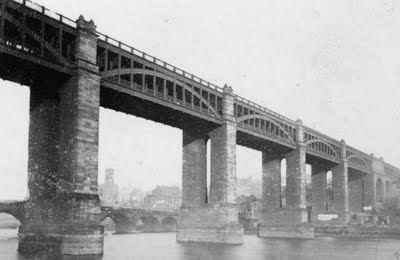
Here's the High Level Bridge with the stone bridge in the background
1849 June 7. The Mayor of Gateshead, Mr. Hawks, one of the
firm of Messrs. Hawks, Crawshay, and Co., the contractors for
the iron work of the High Level Bridge across the Tyne, at
Newcastle, drove the last key of that splendid and stupendous
structure into its place, thereby closing the arches, in the presence
of a numerous party. Mr. Hosking, superintendent of Messrs.
Hawks and Crawshay's works, examined what the Mayor had
done, and announced that the key was well driven and an excellent
fit. His worship and a number of friends dined together at Miss
Murray's, Half Moon Inn, to commemorate the occasion, and the
men working on the bridge were plentifully regaled with strong
ale. August 15th, the bridge was opened without any ceremony,
but was not brought into ordinary use until the 4th February,
1850. The structure consists of six arches, each having a span of
125 feet, with two curved approaches 66 feet in length, the whole
being formed of cast iron pillars and arches, from designs by
Robert Stephenson. The contract for the metal work was taken
by Messrs. Hawks, Crawshay, and Co., for 112,000, and they
were assisted in completing it by Messrs. Losh, Wilson, and Bell,
who executed the approaches, and by Messrs. Abbot and Co., who
east the arches. The total weight of iron employed was 5,050
tons. The length of the viaduct is 1,337 feet, length of waterway
512 feet, height from high water mark to the line of railway 112
feet, and to the carriage-way 85 feet. The erection of the bridge
and viaducts required the removal of 655 families in Newcastle
and 130 in Gateshead, which necessarily added much to the
expense of the undertaking, which was as follows : Cost of
bridge, 243,000; approaches, 113,153; land and compensa-
tion, 135,000; total, 491,153.
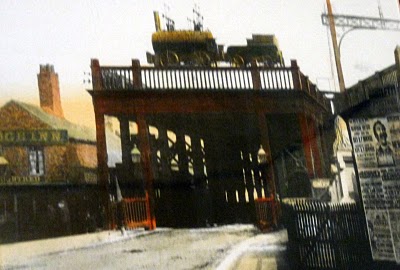
This is Robert Stephenson's High Level Bridge with his father's Billy on the top. Also note the original Bridge pub
1866 June 24. An alarming fire broke out in the Close, Newcastle,
this morning, resulting in the destruction of a large flour mill
and grain warehouses, and part of the High Level Bridge.
The fire was the most destructive that had occurred in this district
since the Gateshead explosion. The damage was estimated at
30,000, and this was considered a low estimate. The flour
mill and warehouses were the property of Mr. Robert Brown.
The idea for a bridge at the location of the present Tyne Bridge dates back to 1864, due to concern about the cost of tolls on the High Level Bridge - although the first serious discussions took place in 1883. Committees met over the next three decades, but it wasn't until the early 1920s that proposals were commenced in earnest, boosted by the chance to secure central government funding. On 29 April 1924, Newcastle and Gateshead approved the plans, and the Newcastle upon Tyne and Gateshead (Corporations) Bridge Act was passed on 7 August that year, with an estimated cost of £1 million including land acquisitions.
While dealing with the Tyne here's snippets of news from the Historical Register of 1833 and 1834
1833 June 13. The largest number of salmon was caught in the
Tyne that had taken place for many years. Between four and five
hundred were brought into Newcastle market, and were readily
sold at from 6d. to 8d. per pound.
1834 January 28. Newcastle Gateshead and the neighbourhood was visited by a severe storm, of wind and rain, as were all the western parts of the county. From the circumstance of the Tyne rising to an enormous height and overflowing its banks, the whole of the district below Blaydon, including Derwenthaugh, Scotswood, Dunstan, &c., was completely under water, and in many of the houses it was nearly up to the second floor.
1834 March 20. A fine vessel of a boat eight keels burden, and the
only one ever built above ie west of the Tyne bridge, was launched at Chatham (western end of Pipewellgate), in the presence of a large assemblage of spectator*.
She was called The Frolic, and intended for the Baltic trade.
1838 January 6. Frost of an extreme intensity prevailed throughout
the northern counties, and the first snow of the winter fell
this day, the wind blowing keen from the north-east, the storm
continued with great severity till the end of the month. All
passage on the river Tyne was stopped, it being frozen for upwards
of five miles below Newcastle, and crowds of skaters appeared
upon it. In no year since the celebrated frost of 1814
had one occurred like the present. In proof of this it may be
mentioned that loaded carts crossed the Tyne, the Coquet, the
Tweed, and other rivers in the north, upon the ice at various
points.
1838 September 4. Thomas Cowley. a pipemaker, of Gateshead,
undertook, for a trifling wager, to leap from Newcastle bridge
into the Tyne and was drowned. A more successful act of folly
of the same kind was perpetrated in September, 1850.
1840 February 1. A dreadful collision took place in the river
Tyne, near Friar's Goose. The London Merchant Steamer was
going down the river on her voyage to London, and the brig Good
Intent, from Lynn, laden with flour, was sailing up, towed by
the steam-tug Margaret, when they came violently in contact
with each other. The Good Intent was struck on the larboard-bow,
and in a few minutes went down. The crew had just time to save
their lives.
1866 September 17. Arrangements having been made by the River
Tyne Commissioners with the Corporation of Newcastle, the
Lords of the Admiralty gave their consent to erect a new bridge
on the site of the old Tyne Bridge, which was opened in the year
1781. The new bridge is to have an opening in the middle, in the
form of a swing, to admit of the passage of ships to the upper
part of the river. This morning a temporary wooden bridge,
which had been erected across the Tyne, was formally opened!
There was no ceremony, and the only circumstance which gave the
event an official aspect was the attendance of a few of the River
Tyne Commissioners. The structure, though only of a temporary
character, has been built in a most substantial manner. Workmen
have now commenced to remove the old bridge.
The Swing Bridge opened in 1876.

Here's the High Level Bridge with the stone bridge in the background
1849 June 7. The Mayor of Gateshead, Mr. Hawks, one of the
firm of Messrs. Hawks, Crawshay, and Co., the contractors for
the iron work of the High Level Bridge across the Tyne, at
Newcastle, drove the last key of that splendid and stupendous
structure into its place, thereby closing the arches, in the presence
of a numerous party. Mr. Hosking, superintendent of Messrs.
Hawks and Crawshay's works, examined what the Mayor had
done, and announced that the key was well driven and an excellent
fit. His worship and a number of friends dined together at Miss
Murray's, Half Moon Inn, to commemorate the occasion, and the
men working on the bridge were plentifully regaled with strong
ale. August 15th, the bridge was opened without any ceremony,
but was not brought into ordinary use until the 4th February,
1850. The structure consists of six arches, each having a span of
125 feet, with two curved approaches 66 feet in length, the whole
being formed of cast iron pillars and arches, from designs by
Robert Stephenson. The contract for the metal work was taken
by Messrs. Hawks, Crawshay, and Co., for 112,000, and they
were assisted in completing it by Messrs. Losh, Wilson, and Bell,
who executed the approaches, and by Messrs. Abbot and Co., who
east the arches. The total weight of iron employed was 5,050
tons. The length of the viaduct is 1,337 feet, length of waterway
512 feet, height from high water mark to the line of railway 112
feet, and to the carriage-way 85 feet. The erection of the bridge
and viaducts required the removal of 655 families in Newcastle
and 130 in Gateshead, which necessarily added much to the
expense of the undertaking, which was as follows : Cost of
bridge, 243,000; approaches, 113,153; land and compensa-
tion, 135,000; total, 491,153.
This is Robert Stephenson's High Level Bridge with his father's Billy on the top. Also note the original Bridge pub
1866 June 24. An alarming fire broke out in the Close, Newcastle,
this morning, resulting in the destruction of a large flour mill
and grain warehouses, and part of the High Level Bridge.
The fire was the most destructive that had occurred in this district
since the Gateshead explosion. The damage was estimated at
30,000, and this was considered a low estimate. The flour
mill and warehouses were the property of Mr. Robert Brown.
The idea for a bridge at the location of the present Tyne Bridge dates back to 1864, due to concern about the cost of tolls on the High Level Bridge - although the first serious discussions took place in 1883. Committees met over the next three decades, but it wasn't until the early 1920s that proposals were commenced in earnest, boosted by the chance to secure central government funding. On 29 April 1924, Newcastle and Gateshead approved the plans, and the Newcastle upon Tyne and Gateshead (Corporations) Bridge Act was passed on 7 August that year, with an estimated cost of £1 million including land acquisitions.
and opened on 10 October by King George V and Queen Mary, who were the first to use the roadway travelling in their Ascot landau. The Tyne Bridge's towers were built of Cornish granite and were designed as warehouses with five storeys. However, the inner floors of the warehouses in the bridge's towers were not completed and, as a result, the storage areas were never used. Lifts for passengers and goods were built in the towers to provide access to the Quayside although they are no longer in use.[1]
The bridge was originally painted green with special paint made by J. Dampney Co. of Gateshead. The same colours were used to paint the bridge in 2000. The bridge spans 531 feet (162 m) and the road deck is 84 feet (26 m) above the river level.
The Redheugh Bridge.
The first opened in 1871 and carried pedestrians and vehicles. Between 1897 and 1901 the bridge was reconstructed.
Hunger marchers crossed the bridge in 1922, without paying the toll. They were protesting about their conditions during the trade depression after the First World War.

